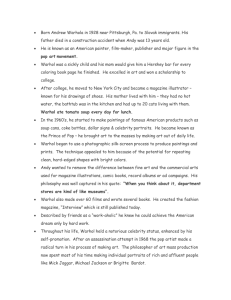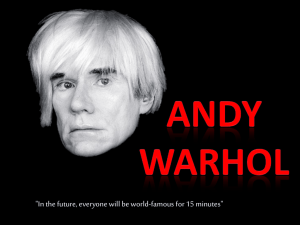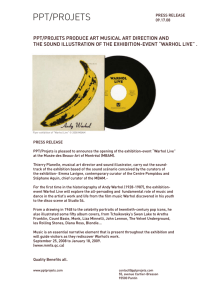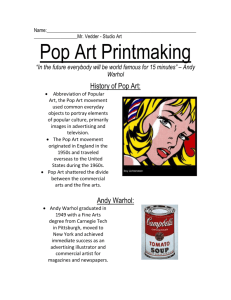Document
advertisement
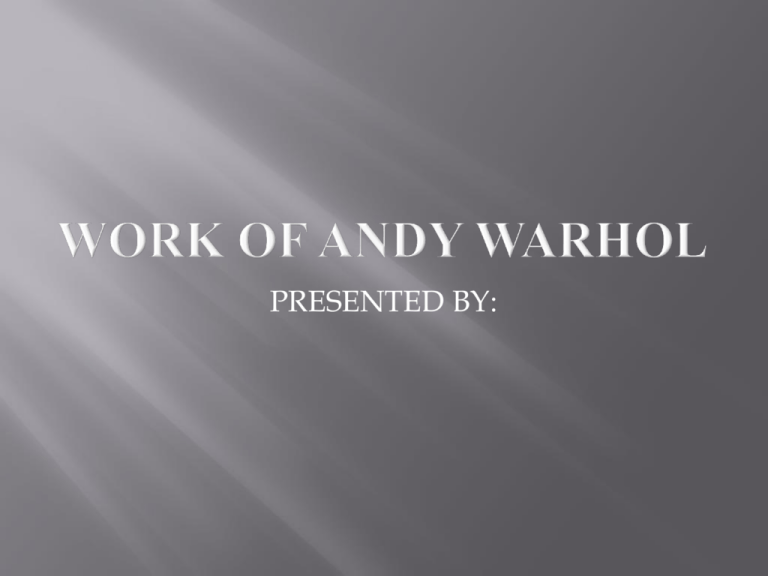
PRESENTED BY: Born Andrew Warhola on August 6, 1928, in the neighborhood of Oakland in Pittsburgh, Pennsylvania, Andy Warhol's parents were Slovakian immigrants. His father, Ondrej Warhola, was a construction worker, while his mother, Julia Warhola, was an embroiderer. They were devout Byzantine Catholics who attended mass regularly, and maintained much of their Slovakian culture and heritage while living in one of Pittsburgh's Eastern European ethnic enclaves. Warhol attended Holmes Elementary school and took the free art classes offered at the Carnegie Institute (now the Carnegie Museum of Art) in Pittsburgh. In 1942, at the age of 14 he graduated from college with his Bachelor of Fine Arts degree in 1949, Warhol moved to New York City to pursue a career as a commercial artist In the late 1950s, Warhol began devoting more attention to painting, and in 1961, he debuted the concept of "pop art"—paintings that focused on mass-produced commercial goods. In 1962, he exhibited the now-iconic paintings of Campbell's soup cans Warhol's early commercial illustration has recently been acclaimed as the arena in which he first learned to manipulate popular tastes. His drawings were often comic, decorative, and whimsical, and their tone is entirely different from the cold and impersonal mood of his Pop art. Much debate still surrounds the iconic screenprinted images with which Warhol established his reputation as a Pop artist in the early 1960s. Although artists had drawn on popular culture throughout the 20th century, Pop art marked an important new stage in the breakdown between high and low art forms. Warhol's paintings from the early 1960s were important in pioneering these developments, but it is arguable that the diverse activities of his later years were just as influential in expanding the implications of Pop art into other spheres, and further eroding the borders between the worlds of high art and popular culture. Although Warhol would continue to create paintings intermittently throughout his career, in 1965 he officially retired from the medium to concentrate on making experimental films. Despite years of neglect, these films have recently attracted widespread interest, and Warhol is now seen as one of the most important filmmakers of the period. Although best known for his silkscreen paintings, Andy Warhol was also an excellent draughtsman. Drawing was a constant part of his artistic practice. As a child he took classes at the Carnegie Museum of Art, and he won several awards for drawings he produced in high school. At Carnegie Institute for Technology (now Carnegie Mellon University), where Warhol earned a degree in pictorial design, his offbeat, nontraditional and sometimes irreverent drawing style did not always meet his professors’ academic standards. At one point they forced him to do extra work over the summer to remain in good standing at school. Upon graduation, Warhol moved to New York to begin his commercial design career In the 1950s Warhol used a “blotted line” technique to develop a signature style for his illustrations. Blotted line combines drawing with very basic printmaking, and it enabled Warhol to create a variety of illustrations along a similar theme. The process had many complex components. Warhol’s impact on art and society was tremendous; this paper offers a highly restricted view of his potential for consumer researchers. By applying some methods of art criticism to his vast body of work, insight was gained in key areas of consumer research: brand equity; clothing, fashion and beauty; imagery; packaging; and selfconcept. Art history is equipped with much more theoretically challenging theories and frameworks-this paper gleaned insights from a surface skimming of the treasures of art criticism and art history. Further work is necessary to articulate how art historical techniques might complement literary tools that have earned a place within the consumer researcher’s toolbox. As we move into a postmodern society, dominated by visual images, informed by five hundred cable television channels, and obsessed with global symbols, visual literacy takes on greater importance to both the consumer and marketer. Art criticism seems a useful area to study the central role images play in consumer behavior-joining successful applications of other humanities based approaches. Marketing, in particular, encourages symbolic associations: products to images, images to products. To fully understand consumer behavior requires an appreciation of the long heritage of art scholarship. This project represents a step toward mining the rich ground of art history to extract nuggets of wisdom about consumers and the society they live in. Holbrook, Morris B. and R. B. Zirlin (1985), "Artistic Creation, Artworks and Aesthetic Appreciation," in Advances in Nonprofit Marketing, vol. 1, ed. Russell Belk Greenwich, CT: JAI Press, 1-54. Goldthwaite, Richard A. (1993), Wealth and the Demand for Art in Italy 1300-1600, Baltimore: John Hopkins University Press Bogart, Michele H. (1995), Artists, Advertising, and the Borders of Art, Chicago: University of Chicago Press. Schroeder, Jonathan E. (1992), "Materialism and Modern Art," in Meaning, Measure, and Morality of Materialism, ed. Floyd Rudmin and Marsha Richins, Provo, UT: Association for Consumer Research, 10-14. Hackett, Pat (ed.) (1989), The Andy Warhol Diaries, New York: Warner
